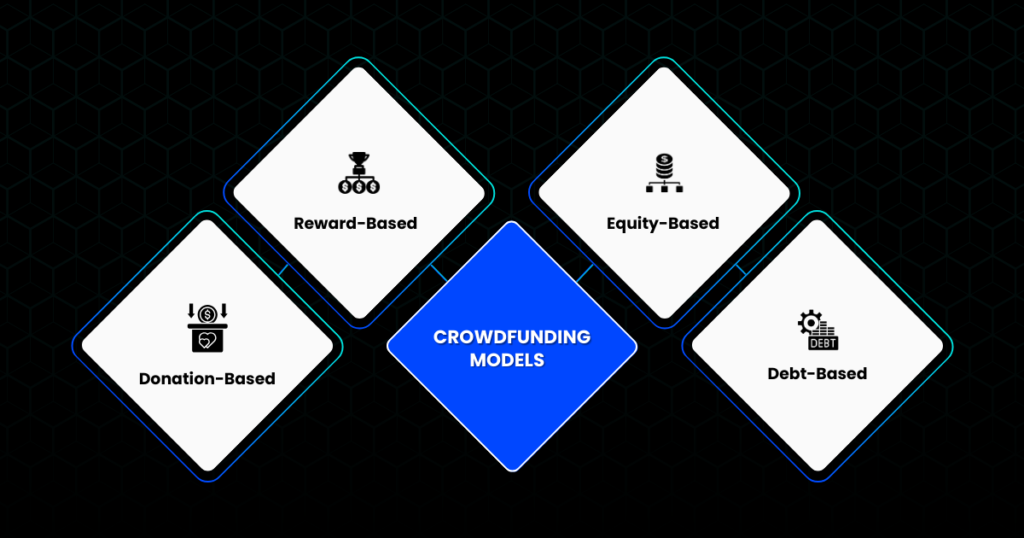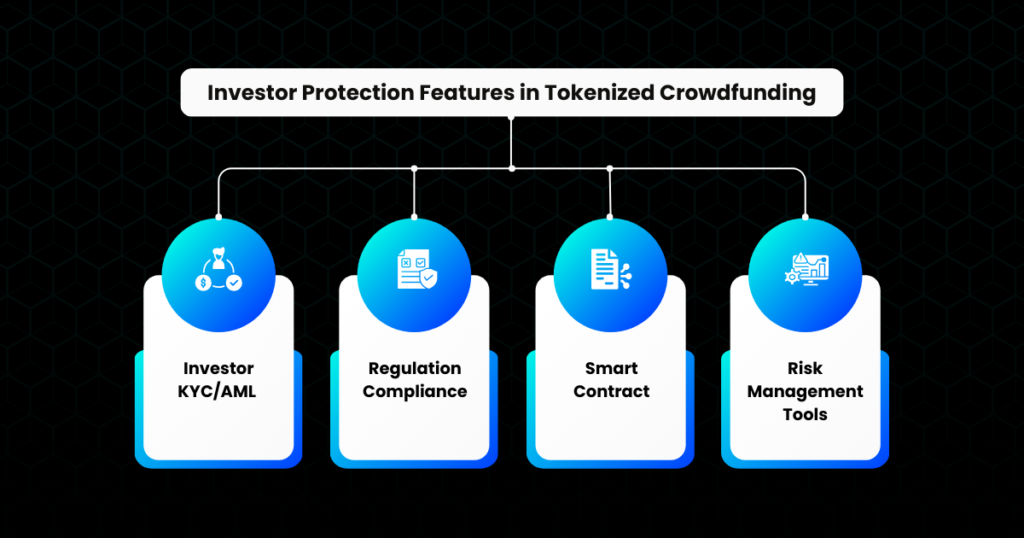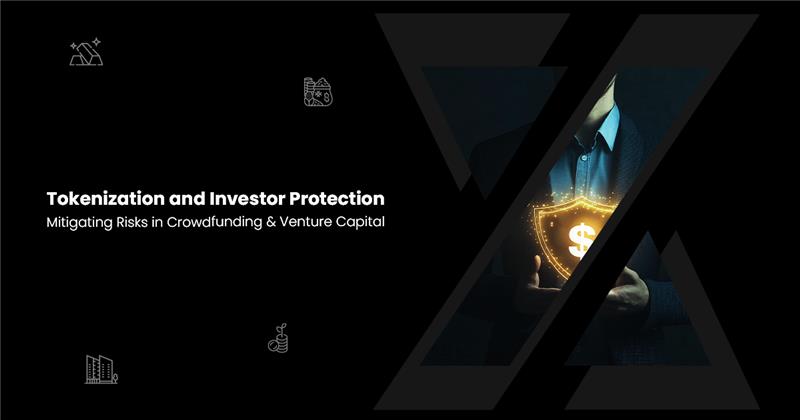Crowdfunding is picking up pace with its increased popularity among major stakeholders including project creators, bankers, investors, and many a time regulatory body. This interest resulted in an alleviating global market that is expected to reach approximately USD 1.74 billion by 2025 with a strong compound annual growth rate (CAGR) of 15.7%. This detonation in crowdfunding’s market value demonstrates its popularity among stakeholders to raise capital from a large mass to finance a project or business.
The assimilation of tokenization in crowdfunding makes it more efficient by digitalizing assets and optimizing management. At its core, tokenization allows representation of the investors’ ownership in a project or business including corporate bonds and shares of a company in the form of digital tokens. Further tokenization allows fractional ownership in venture capital enabling several investors to co-own shares in a business or projects.
In this write-up, we’ll discuss the need for investor protection in crowdfunding and venture capital, key protections for investors participating in tokenized crowdfunding, crowdfunding models, and overcoming challenges in crowdfunding and venture capital.
Why Investor Protection is Critical in Crowdfunding and Venture Capital?
The domain of crowdfunding and venture capital is gaining traction among investors, businessmen, and regulatory bodies. However, there are certain crowdfunding risks and a need for venture capital protection. These innovative investment frameworks are aiding in raising funds for startups and businesses through collective contributions. This is why, it is important to protect investors in crowdfunding and venture capital models. There are multiple models for crowdfunding such as donation-based, reward-based, equity-based, and debt-based.

Crowdfunding allows entrepreneurs to raise capital from a pool of investors, while venture capital incorporates larger investment sizes from specialized firms. With these increased adoptions, investors remain vulnerable to certain threats and challenges. One of the most crippling challenges includes regulatory framework which can be addressed by tokenization.
Due to the dynamic nature of these investment models, investor protection is critical to establishing trust and drawing the attention of both retail as well as institutional investors. Tokenization and investor protection go hand in hand due to various features such as enhanced security, transparency, and risk mitigation in crowdfunding and venture capital.

How Tokenized Crowdfunding Protects Investors?
The integration of tokenization of crowdfunding helps in multiple ways in managing and providing transparency among the stakeholders. There are numerous benefits of tokenization for investors, businessmen, and project owners. These are some key protections for investors participating in tokenized crowdfunding:
Know Your Customer (KYC) and Anti-Money Laundering (AML)
Tokenization adheres investors to Know Your Customer (KYC) and Anti-Money Laundering (AML) processes. These measures are important in tokenized crowdfunding which verifies investors’ identity and establishes an environment for safer investments. These protective measures help platforms ensure regulatory compliance in tokenization and tokenized assets. This step builds trust among the stakeholders and maintains the integrity of the crowdfunding.
Regulation Compliance
Platforms for tokenized crowdfunding must follow the required and relevant regulatory measures to protect investors. Their compliance with the laws and rules fosters an environment that offers transparent offerings for investors. This legal structure helps in mitigating risks in crowdfunding, including fraud and misrepresentation. This approach encourages confidence among the participants while addressing fundraising efforts.
Smart Contract
Tokenization leverages smart contracts in crowdfunding and automates the process with already coded and self-executing contracts. This not only saves time but also reduces dependency on the intermediaries. Further, by incorporating administrative rules, smart contracts increased trust among the stakeholders participating in crowdfunding.
Risk Management Tools
Further platforms for tokenized crowdfunding assimilate a considerable amount of risk management tools to build a more reliable environment. These tools incorporate analytics dashboards, performance metrics, and market insights, providing transparent project and business commencement.

Overcoming Challenges in Crowdfunding and Venture Capital
| Challenges | Solutions Offered by Tokenization |
| Restricted Investor Access | Tokenization by providing fractional ownership allows all range of investors to participate in tokenized crowdfunding and venture |
| High Administrative Costs | Tokenization enables smart contracts that automates the process and reduces the need for intermediaries like banks, financial institutions, trustees, and custodians. |
| Illiquidity in Investments | Tokenization is a digital process and so as the trade in tokenized assets which ensures liquidity in the investments. |
| Insufficient Transparency | Tokenization by leveraging blockchain technology allows secure, immutable and transparent record of transactions and ownership. |
| Lack of Trust Among Investors | Tokenization by utilizing blockchain technology allows a transparent ecosystem that encourages trust among the investors and increasing participation. |
| Regional Limitations | Tokenization allows participants around the globe to engage in the trading and investments without any dependency on the third part, overcoming regional limitations. |
| Delayed Fundraising Efforts | Tokenization allows swift and efficient transactions, resulting in smooth and faster fundraising efforts. |

As tokenization in real-world assets is gaining momentum in the market; several platforms allow their trading and investment. One such platform is STOEX.
STOEX is backed by KALP Distributed Ledger Technology (DLT) and strictly adhered to regulatory compliance, ensuring transparency and liquidity. With its structured approach, stringent security, and commitment to compliance, the platform offers an appealing option for diversified and efficient investing. Its regulation, security measures, focus on usability and customer-centric approach make it stand out as an accessible way of trading tokenized real-world assets.
Additionally, STOEX’s vision is to build a ground with reduced entry barriers and encourage a safe ecosystem for every individual interested in investing in the market. It pulls the strings of financial democratization by bridging the gap between investors and high-worth tokenized RWAs.
Closing Reflections
The synthesis of tokenization in crowdfunding and venture capital has transformed these investment models by increasing investor protection and addressing several risks and misinterpretations. Further, it allows several benefits such as liquidity, transparency, automation in the process, immutability, and global accessibility. These features enhance investors’ and other stakeholders’ experiences and build trust among them. Crowdfunding and venture capital are expanding the domain of finance, where tokenization by leveraging its fundamental components like blockchain technology and smart contracts can make these models more efficient.
As these concepts are still evolving, various platforms are adding to the layer of opportunities and options within these domains. One such option is STOEX, which allows investors to access the marketplace and trade effortlessly.
FAQs
How does tokenization reduce risk in crowdfunding?
Tokenization mitigates risks by enabling transparency, reducing fraud, and providing a clear audit trail for transactions.
What is the role of smart contracts in investor protection?
Smart contracts automatically execute agreed-upon terms that reduce the risk of mismanagement or fraud.
Are tokenized investments more liquid than traditional venture capital?
Yes, tokenized investments allow for fractional ownership, allowing trade of small parts of their holdings, hence increasing liquidity compared to traditional venture capital.
What legal issues arise with tokenized investments?
Tokenized investments must comply with securities laws, including KYC/AML regulations and securities offerings rules, which can be complex and challenging.
Can tokenization prevent fraud in crowdfunding?
While tokenization can reduce certain risks associated with fraud, it’s important that tokenized platforms implement strong regulatory and security measures.


